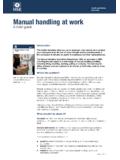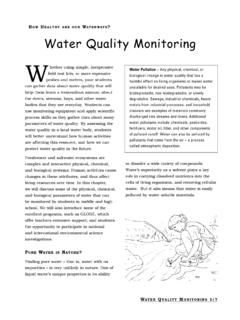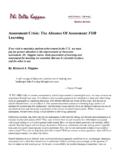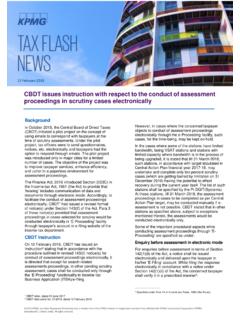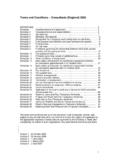Transcription of Failure Rate and Event Data for use within Risk …
1 Page 1 of 96 Failure Rate and Event Data for use within Risk Assessments (28/06/2012) Introduction 1. HID CI5 has an established set of Failure rates that have been in use for several years. This document details those items and their Failure rates . For items not within this set, or for which no values are currently available the inspector carrying out the assessment should estimate Failure rates after discussions with Topic Specialists. The Failure rates quoted within this document were derived and are intended for use on Land Use Planning cases. They were NOT originally intended for use in COMAH Safety Report assessment because they do not necessarily take account of all factors that could be relevant and significant at particular installations.
2 However, in the absence of site specific data, the values given here may serve as a starting point for safety reports. 2. Figure 1 shows the different types of information that are available in this document. For the full structure, see Figure 2. This introductory section also outlines a framework used in HID CI5 to keep references pertaining to Failure rates and a system for recording the use of non-generic Failure rates used in particular cases. Failure rate and Event dataEvent dataEDFailure rateFRHuman factorsHF Figure 1 Information covered in Chapter 6K 3. The first section covers Failure rates . HID CI5 currently has established Failure rates or has some information for most of the items. The items on the diagram in Figure 2 contain a Failure rate value(s) and a brief derivation.
3 For rates that have ranges the derivation also contains a brief guide on what factors may affect the value. 4. The second section (see page 80) contains information on Event data. The derivation of the rates to be used and how to use them are described. Page 2 of 96 5. The third section (see page 92) covers human factors. This aim of this section is to help non-human factors specialists determine whether the use of human reliability analysis, and associated values, is adequate or 3 of 96 Failure rate and Event dataEvent dataEDFailure and and temperatureand pressure 1 probabilitiesED6 Ship strike ratesED1 WeatherED5 Spherical Road Figure 2 Overview of PCAG 6K structurePCAG chp_6K Version 12 28/06/12 Page 4 of 96 Failure rates Generic Failure rates 6.
4 Many of the Failure rates used in risk assessments within HID CI5 are based on values derived for RISKAT (RISK assessment Tool) as detailed in the various parts of the Major Hazards assessment Unit (MHAU) Handbook (now archived). These generic rates were derived in the early 1980 s when MHAU was first formed and have an established pedigree. They were originally derived in the context of assessing risks from chlorine plants. They have been added to and amended as needed in order to assess different types of plant and operations and Figure 2 has been extended accordingly. The value, type of release and derivation can be found in this document for items shown in Figure 2. The assessor needs to decide whether or not the generic Failure rates are appropriate for their assessment ; if the generic Failure rate is inappropriate then further work is required to derive a suitable specific Failure rate.
5 Non Generic Failure rates 7. The application of these generic Failure rates to items being used for substances, processes and plant designs that might induce particularly arduous operating conditions or, alternatively, provide for increased reliability is a matter of judgement by the assessor. The greatest difficulty in assigning Failure rates is the lack of appropriate industry Failure rate data but, in the absence of Failure rate data specific to particular plant, processes and substances, the generic values given in this section should be used as a starting point. These generic values can be modified to take account of site-specific factors. The specific Failure rates are determined by expert judgement by the Topic Specialist, taking account of significant factors along with any specific data available.
6 In this case, the Topic Specialist will record the recommended rates in a Failure Rate Advice (FR) note. 8. When non-generic values are used in HID CI5 assessments they should be justified and the reasoning behind their derivation recorded within an FR note. If the assessment case is panelled for peer review the relevant FR note should be presented with the case so that HID CI5 inspectors can endorse the value(s) used. The Topic Specialist will place completed FR notes on TRIM and a note made alongside the appropriate generic Failure rate. Description of the Information Required Failure RATE ADVICE Requested By: Request No: Date: Request: Advice: Basis of Advice: Associated Documents: Signed: Date: PCAG chp_6K Version 12 28/06/12 Page 5 of 96 Item FR 1 Mechanical 9.
7 Failure rates for equipment classified as mechanical are categorised as follows: Item FR Vessels Page 6 Item FR Components Page 32 Item FR Pipework Page 47 PCAG chp_6K Version 12 28/06/12 Page 6 of 96 Item FR Vessels 10. Failure rates for vessels are split into four categories that are further subdivided as shown in Figure 3 below. These vessels refer to fixed storage.
8 Moveable storage ( drums) are considered under Item FR 4. temperatureand pressure Figure 3 Hierarchical Diagram for Vessels PCAG chp_6K Version 12 28/06/12 Page 7 of 96 Item FR Ambient Temperature and Pressure Vessels 11. Ambient temperature and pressure vessels are divided as follows. Ambient pressure may be extended to cover vessels at slightly elevated pressure. Item FR Large Vessels Page 8 Item FR Small and Medium Atmospheric Tanks Page 10 Item FR Non Metallic/Plastic Page 12 PCAG chp_6K Version 12 28/06/12 Page 8 of 96 Item FR Large Vessels ITEM Failure rates Type of Release Failure Rate (per vessel yr) Notes Catastrophic 5 x 10-6 Major 1 x 10-4 Minor x 10-3 Roof 2 x 10-3 RELEASE SIZES Hole diameters for Tank volumes (m3)
9 Category >12000 12000 4000 4000 - 450 Major 1000 mm 750 mm 500 mm Minor 300 mm 225 mm 150 mm Derivation 12. The Failure rates apply to fixed position, single walled vessels with a capacity greater than 450m3, which operate at ambient temperature and pressure. 13. Roof failures includes all failures of the roof and does not include liquid pooling on the ground. For vessels that are storing flammable liquids, this could lead to a flammable atmosphere being formed and possible ignition and escalation. For tanks that store toxic chemicals a toxic cloud could be formed. Most atmospheric storage tanks are specifically designed so that the roof wall seam will preferentially fail hopefully mitigating the effects of an incident.
10 14. The above rates are derived from historical data in work carried out by Glossop (RAS/01/06). They are applicable to large flat-bottomed metal storage vessels where flammable liquids are stored at atmospheric temperature and pressure. These values are not directly applicable to vessels storing non-flammable liquids because a different set of Failure modes is relevant. However, they may be used as a basis for such vessels seek advice from the Topic Specialist. References Title Author Date Comments Failure rates for Atmospheric Storage Tanks for Land Use Planning.













